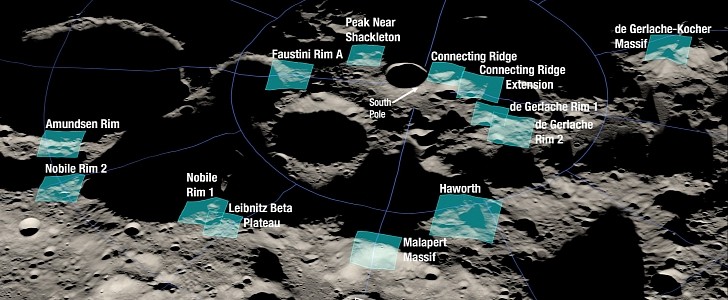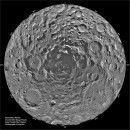Assuming all goes as planned, in a little over a week, NASA will kickstart the Artemis Moon exploration program. Artemis I will be the first flight in a series of increasingly complex missions meant to pave the way for humanity's return to the satellite. To prepare for Artemis III, the first mission that will put astronauts on the lunar surface, NASA has identified several potential landing regions near the lunar South Pole.
If the agency sticks to its plans, it will launch Artemis III in 2025. This will be the first time astronauts will put their boots on the Moon since the Apollo 17 mission in 1972. But before it begins the next chapter of space exploration, the agency must set the stage for the next astronauts that will touch the lunar surface.
To that end, NASA has identified 13 potential landing zones near the lunar South Pole, a region filled with deep craters and mountains that has never been explored by humans. The agency chose these many landing zones to maintain launch flexibility throughout the year.
The selection was based on multiple criteria. A team of scientists looked at areas that could provide a safe landing. That terrain had to be relatively flat and also well illuminated. Astronauts also must be able to communicate with the teams on Earth. The combined capabilities of the Orion spacecraft that will carry the crews, the Space Launch System (SLS) rocket, and SpaceX's Starship system were also taken into account by scientists.
They looked at areas near showed areas as well. This will allow Artemis astronauts to study the water ice that was found in the permanently shadowed regions at the lunar South Pole.
"Lunar water ice is valuable from a scientific perspective and also as a resource, because from it we can extract oxygen and hydrogen for life support systems and fuel," said Jacob Bleacher, chief exploration scientist for NASA.
Additionally, every potential landing spot has sites that are constantly hit by sunlight. It's important for astronauts to have access to sunlight during their missions since it is a source of energy for everything that is solar-powered.
Sites within these 13 regions have yet to be chosen. NASA plans to select them once it sets the launch dates for Artemis III. You can take a look at the video provided by NASA Goddard to see exactly where these zones are located.
To that end, NASA has identified 13 potential landing zones near the lunar South Pole, a region filled with deep craters and mountains that has never been explored by humans. The agency chose these many landing zones to maintain launch flexibility throughout the year.
The selection was based on multiple criteria. A team of scientists looked at areas that could provide a safe landing. That terrain had to be relatively flat and also well illuminated. Astronauts also must be able to communicate with the teams on Earth. The combined capabilities of the Orion spacecraft that will carry the crews, the Space Launch System (SLS) rocket, and SpaceX's Starship system were also taken into account by scientists.
They looked at areas near showed areas as well. This will allow Artemis astronauts to study the water ice that was found in the permanently shadowed regions at the lunar South Pole.
"Lunar water ice is valuable from a scientific perspective and also as a resource, because from it we can extract oxygen and hydrogen for life support systems and fuel," said Jacob Bleacher, chief exploration scientist for NASA.
Additionally, every potential landing spot has sites that are constantly hit by sunlight. It's important for astronauts to have access to sunlight during their missions since it is a source of energy for everything that is solar-powered.
Sites within these 13 regions have yet to be chosen. NASA plans to select them once it sets the launch dates for Artemis III. You can take a look at the video provided by NASA Goddard to see exactly where these zones are located.







